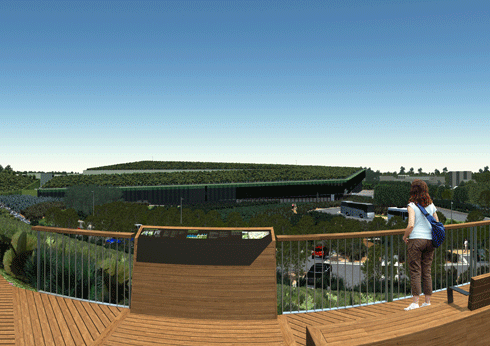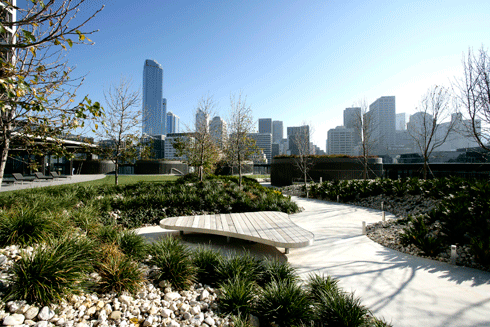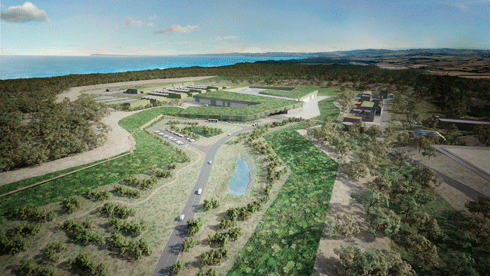
|
Published: 4 July 2011
Green roofs and walls are growing up
Environmental roof and wall installations are in vogue across the country for their touted efficiencies and cosmetic attractiveness. Architects, engineers, landscape gardeners, horticulturalists and even ecologists are teaming up to advance the base technology in Australia.
Geoff Heard has been up all night lately, installing sections of the biggest green roof in the southern hemisphere. Mr Heard is Managing Director of leading Australian green roof and wall company, Fytogreen, who won the bid to design and install the complex and locally sympathetic landscaping on Victoria’s new desalination plant – soon to be Australia’s largest reverse osmosis facility.
Designed and constructed by Thiess Degrémont, the complex nestles behind the coastal dunes of the Bass Coast, and has had to be sensitively designed to meet visual, noise and ecological requirements. The roof of the main building is central to meeting those requirements.
‘We’re helping to bring the complex into a functional environmental envelope with the landscape design of this roof,’ says Mr Heard. He explains that Fytogreen established a prototype at Waratah Bay to evaluate of a range of plant species for functional and design life suitability.
‘We are approximately 22 per cent of the way through the green roof installation with part of the southerly and northerly sections of the reverse osmosis building,’ says Mr Heard. ‘All going according to plan, we’re looking at completion of all 26 000 square metres of the facility later this year.’
‘The roof landscape will mirror the ecological profile of the primary and secondary dunes off the east side of the complex, and the site’s native ground-level plantings around the west side. The plant species list has been developed in conjunction with Thiess Degrémont’s ecologist and then sourced by our horticulturalist directly from local native stock – as both seed and cuttings.’
The roof has important technical jobs to do: attenuate noise from the reverse osmosis plant beneath it, reduce heat transfer to and from the plant building, and collect water to irrigate its planted sections.

|
|
An impression of the main desalination plant building from the observation deck. Credit: Courtesy of Thiess Degrémont
|
Mr Heard says these demands of a green roof – overlaid with the variability and harshness of the local Australian climate – made the superstructure’s design a unique challenge. Architects ARM and peckvonhartel worked with landscape architects ASPECT Studios on the multi-functional plans, which Fytogreen’s team are now bringing to life.
Ortech’s ‘Durra Panel’ acoustic membrane forms the base layer of the roof structure. Next up is a leak detection layer, then ply decking overlaid with a waterproof membrane. A drainage cell layer follows, with a geo-fabric1 on top to ensure the drainage is uncompromised. A resin-generated urea-aldehyde foam, Hydrocell RG30, is made in situ on the roof and then sprayed on. Once that’s set, the complex sub-surface drip irrigation system is installed and tested.
Fytogreen’s special growing layer, which sustains the roof vegetation, is then spread on. It’s made up of Hydrocell 40 flakes, scoria and composted pine bark. The native flora species are then planted, and controlled-release fertiliser added to the next layer of dark scoria mulch, which completes the landscaping for retention and form.
Rating Australia’s green installations
Mr Heard says the desalination plant project represents ‘massive steps forward’ for Fytogreen and green roof technology in terms of ability to build to such a scale in Australian conditions. The job adds to the company’s extensive experience with roof and green wall projects across the country, as well as in Dubai, Hong Kong and California, mostly for corporate clients.
So how does Australia’s expertise in green roofs and walls rate internationally, and what are the nett environmental pros and cons of these installations?
Sidonie Carpenter, president of the small voluntary representative body Green Roofs Australia, says there has been an increase in national take-up of green roof and wall installations over recent years, in the both the commercial and domestic sectors. This reflects the growth of sustainable architecture around the world, and the mandating of green roofs and walls by many cities for their perceived functional value.

|
|
The Freshwater Place residential tower by Australand on Melbourne’s Yarra River features an intensive roof garden, installed for residents by Fytogreen. Credit: Fytogreen
|
Mrs Carpenter is concerned at what she sees as the ‘green bling’ phenomenon of these features: where their growing installation trend is based on cosmetic or design popularity, rather than their true environmental credentials. She worries that these might be being over-sold in the commercial excitement.
‘We need to be more honest about our limited understanding of the nett environmental footprint they have in being built, run, and maintained,’ she says. ‘There are a lot of technical and scientific issues still to be solved.’
Some dedicated technical green roof research is being done at Melbourne University’s Burnley campus, in conjunction with Monash University and Melbourne Water. However, Mrs Carpenter says that while Australia is a late starter in testing technology, it has the benefit of watching what breaks overseas in terms of standards.
‘Compared to, say, Singapore’s rapid pace, Australia’s experimentation is generally being held back by a ‘fear factor’ around labour costs and OH&S issues: and there’s a lack of industry skill base here,’ she says.
‘However, despite all that, we can already be proud of the diversity and quality of a number of projects here in Australia. Living Architecture (just published by CSIRO – see the accompanying review in this issue), covers most of them. It’s a very welcome and leading book on green roof and wall technology in our region by specialist architects Graeme Hopkins and Christine Goodwin.’
Asked to gauge the significance of Fytogreen’s green roof for Victoria’s desalination project, Mrs Carpenter said the project will raise the bar, profile and confidence in the sector. ‘Green Roofs Australia commends the government’s foresight in its support for such an ambitious project.’
1 Geo-fabrics or geotextiles are permeable fabrics which, when used in association with soil, have the ability to separate, filter, reinforce, protect, or drain.




